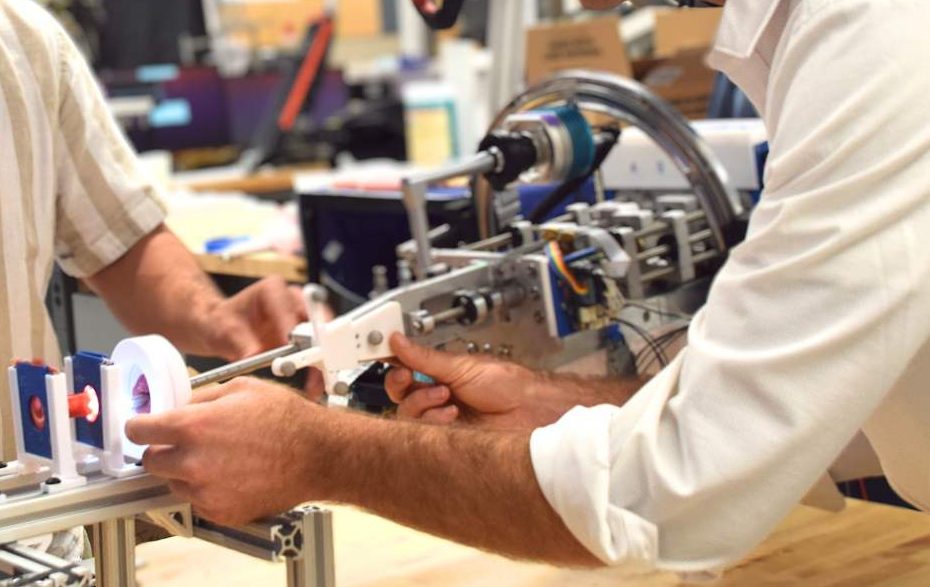2009 Trainees

|
2009 Student Testimonials |
||
|
|
||
2009 REU Students |
||

|
Atiyah Ali Research Abstract: Respiratory syncytial virus is a single-stranded, negative sense RNA virus of the family paramyxoviridae that causes lower respiratory tract infections such as pneumonia and bronchiolitis in infants and children. Currently there is no cure. There have been many approaches towards early detection of the progression of the virus. Previously, the Wright lab has developed DNA functionalized gold filaments capable of fluorometrically detecting genomic viral RNA. However, the binding affinity of the probe to the target sequence has yet to be determined. The goal of this project was to design a quartz crystal microbalance (QCM) experiment that determines the binding affinity of the probe towards the viral RNA. Direct surface functionalization of 5 MHz quartz crystals was attempted by flowing thiolated probe over the crystal. The crystal was subsequently treated with blocking agent and the target RNA flowed afterward. Unfortunately, this method was unsuccessful in that there was minimal binding of the probe and little to no binding of the target RNA. A second method was employed in which the probe was incubated with the crystal while being monitored by the QCM. Although this method has not been thoroughly tested, the preliminary results suggest that the binding constants for this system can be determined. |
|

|
Briana Baxter Research Abstract: Natural products provide an immense chemical diversity that is of great relevance to drug discovery. However, the many stages of the drug discovery process can take years to complete. This is a major challenge because of the steadily increasing need for the discovery and development of novel drugs for the treatment of infectious disease, autoimmunity, and cancer. Recent successes illustrate the role of ion mobility mass spectrometry as a more effective method to provide rapid two-dimensional gas phase separations to structurally characterize and identify analytes in complex samples. This has lead to the use of matrix-assisted laser desorption/ionization (MALDI)- ion mobility-mass spectrometry to quickly prioritize which compounds found in a complex crude extract are of interest for further study. Through the use of this instrumentation we aim to accelerate the natural products drug discovery process. |
|

|
Robert Boone Research Abstract: The lipid electrophile, 4-hydroxynonenal(HNE) is a lipid peroxidation byproduct of normal cellular metabolism. This α,β- unsaturated aldehyde is also produced during inflammation and is known to play a pivotal role in many diseases, including Alzheimer’s, cardiovascular disease and cancer. A fluorescence assay was designed to indirectly measure the ability of HNE to enter the cell by monitoring changes in cellular Glutathione (GSH) levels. The mechanism for measuring GSH by Thiol Tracker Violet (Invitrogen) involves the formation of an irreversible covalent bond at a bromomethyl group. This assay will subsequently be used to measure cellular uptake of other lipid electrophiles (ex. 4-oxononenal ). Human colon cancer cells (RKO cells) were treated with various concentrations of HNE and vehicle control and free GSH levels were monitored over time using Thiol Tracker Violet (Invitrogen). As HNE concentration was increased a dose and time dependant decrease in fluorescence was observed. The greatest decrease in fluorescence was observed at the 2hr time point at 50μM HNE, at this juncture the fluorescence was 32% of that observed in the control. Furthermore, at 50μM HNE fluorescence decreased at all successive time points, while the lower concentration of 20μM did not significantly attenuate fluorescence until one hour had passed. These results provide a strong indication that HNE is being taken up by the cell. |
|

|
Rachel Clarke Research Abstract: Apoptolidin A is a natural product produced by Nocardiopsis sp. which selectively induces apoptosis in many cancer cell lines in nM concentrations, and cytotoxicty in µM concentrations. Since its isolation in 1997 several derivatives, also biologically active, have been isolated and characterized from this organism. The purpose of this study is to isolate and characterize other natural products produced by this actinomycete that are biologically active, by varying growth conditions, and structure elucidation by 2D NMR. This will lead to an expansion in the natural product library for compounds produced by Nocardiopsis sp.
Publications: |
|

|
Alysia Ferrebee Research Abstract: A comparative molecular field analysis (CoMFA) based on three-dimensional quantitative structural activity relationship studies (3D-QSAR) was conducted on 118 benzoxazepine derivatives as positive allosteric modulators for the metabotropic glutamate receptor subtype 5 (mGluR5). Two physiochemical properties—sterics and electrostatics—were observed, assumed to account for the major contributions to the intermolecular interactions involved in the binding mechanism of ligand to the receptor. The model with the best predictive ability was obtained using the CoMFA standard model with region focusing, where StDev*Coefficients were assigned as weight values—retaining significant cross-validated correlation coefficients q2(0.583) and r2 (0.813)—from which experimental mGluR5 potentiator results were in fair agreement with actual potentiator values for this class of compounds. The subsequent contour maps were used to assess the structural features pertinent to the bioactivity values of the set of compounds, suggesting that primarily electropositive substituents with a low steric bulk are required at the 3 position of the central, oxazepine moiety, while bulky substituents are required at the meta position of the 1,2,4-triazine ring. This information suggests the potential, statistical significance of this class of compounds, wherein, the resulting contour maps afford insight into the features vital for the design of efficacious benzoxazepine-based analogs as positive allosteric modulators for mGluR5.
Publications:
|
|

|
Carlos Garcia Research Abstract: Staphylococcus aureus is a gram positive bacterial pathogen that is responsible for many diseases that include pneumonia, skin infections and toxic shock syndrome. Recently, large quantities of S100A8/S100A9, often referred to as calprotectin (CP), was detected in S.aureus abscesses. CP is a member of the S100 family of EF-hand calcium-binding proteins, which has been shown to play roles in innate immunity and general inflammatory processes. In tissue abscesses formed by S.aureus, neutrophils export CP into the extracellular milieu where they chelate essential trace metals such as Zn2+ and Mn2+, effectively starving and thereby inhibiting the growth of the microbe. In order to confirm that CP functions through this mechanism, site-directed mutants of metal chelating ligands were tested. The structure and metal binding properties of the S100A8H83N and S100A9D30S mutant proteins were analyzed by structural and biophysical approaches. Two-dimensional heteronuclear nuclear magnetic resonance (NMR) spectroscopy was employed to assess the structural integrity of the mutants. Isothermal titration calorimetry (ITC) was used to measure the Zn2+ affinity. Cell-based experiments were performed to examine the effect of these CP mutants on S. aureus growth. Given that S.aureus is highly resistant to conventional antibiotics, these studies set the stage for future investigations to exploit the metal chelating properties of CP to help in the design of new therapeutics aimed at eradicatingS.aureus in infected tissues. |
|

|
Kristopher Hahn Research Abstract: Extracts of the leaves of the Elaeocarpus grandis have yielded a class of compounds known as the grandisines which possess an affinity towards the δ-opioid receptor. The opioid receptor can be broken down into three main classes; δ, μ, and κ; with harmful side-effects associated with compounds that bind to the μ and κ receptors. The grandisines have exhibited minimal side-effects with the δ-opioid receptor thus increasing its appeal as a potential drug lead. A common feature among the grandisines is an asymmetric indolizidine structure with a substituted double bond along the C7-C8 position. The focus of this study is to synthesize the indolizidine ring structure which will be used to synthesis grandisine B and derivatives and also determine whether the grandisines are acting as an agonist or antagonist to the δ-opioid receptor. The indolizidine ring structure would be functionalized about the C8 substituent through the coupling of alkenylboronic acids which will utilize a Liebskind-Srogl Coupling reaction. Through this functionalization of the indolizidine structure, analogues with higher binding affinity and selectivity to the δ-opioid receptor will be synthesized. |
|

|
Lance Hoffman Research Abstract: The use of quantum-dot conjugated neurotransmitter and drug derivatives is a nascent field with great potential to reveal new insight into biochemical processes. Our work is focused on developing small-molecule fluorescent probes that may be useful for labeling and imaging targets in the central nervous system. It has previously been demonstrated that GABAC receptors expressed in Xenopus laevis oocytes can be labeled with quantum dots conjugated with the GABA agonist Muscimol. However, these conjugates were not useful in mammalian cell cultrures due to nonspecific binding. To overcome this, we have designed and synthesized derivatives of 2,6-dimethoxyphenol (DMP). DMP binds to the Propofol (2,6-diisopropylphenol) binding site on the GABAA receptor. Using these derivatives in conjunction with quantum dots it might be possible to image this receptor in live mammalian cell cultures. To this end we have developed a synthetic methodology which can provide DMP derivatives that can be attached to pegylated quantum dots. |
|

|
Jaime Hutton Research Abstract: Recent advances in ion mobility-mass spectrometry (IM-MS) has allowed for the rapid two dimensional separation of complex mixtures. Analytes are resolved first upon their relative collision cross-section in ion mobility (IM) then further based upon mass, allowing rapid separation of isobaric species. In these experiments, a Synapt HDMS system (Waters Corporation, Manchester, UK), which utilizes traveling wave ion mobility separation, was utilized with a matrix-assisted laser desorption/ionization (MALDI) source was used to analyze lipid populations from Drosophila melanogaster brain neurons. In the first experiment, the instrument was set to scanning mode in order to detect the differences in lipid composition of wild type (WT) Drosophila versus the mutated easily shocked (eas) Drosophila. In the second experiment, MS/MS was performed to fragment lipids of interest from both WT Drosophila and RBO mutants in order to identify the structure of specific lipids that had significant variance in abundance between the two phenotypes. These experiments attempt to provide evidence that MALDI-IM-MS is a viable method for analyzing lipids from a complex mixture, such as whole cell analyte. |
|

|
Connor Lamberson Research Abstract: Smith-Limli-Opitz syndrome (SLOS) is a human autosomal recessive syndrome. It is caused by mutations in the genes that encode 7-dehydrocholesterol reductase, the enzyme that catalyzes the conversion of 7-dehydrocholesterol (7-DHC) to cholesterol, and the syndrome is thus characterized by a build-up of 7-DHC and a deficiency of cholesterol. 7-DHC is extremely reactive with molecular oxygen in radical-catalyzed peroxidation reactions (kp=2260 ± 40 M-1s-1) in comparison to cholesterol (kp=11 ± 2 M-1s-1), and can go through complex mechanistic pathways generating oxysterols that may contribute to the pathology of SLOS. One oxysterol in particular, the 3β,5α-dihydroxycholesta-7-en-6-one, was a minor product in free radical oxidation studies done in organic solvents, but was very prevalent in neuro2a cell and mice brain SLOS models. To further test the biological activity of this oxysterol, it was successfully synthesized from 7-DHC over three steps with an overall yield of 25%. The major step in this synthesis involves the oxidation of the C5=C6 double bond catalyzed by RuO4. Biological tests on this oxysterol will help us determine the importance of the role that this molecule plays in the morphology of the neuro2a cells, mouse brains, and in the pathology of SLOS. We are also attempting to make a deuterated derivative of the compound that could be used to quantify the amount of 3β,5α-dihydroxycholesta-7-en-6-one in neuro2a cell and mice brain SLOS models, establishing this oxysterol as a biomarker of SLOS. These advances will lead to a greater understanding of the pathology of SLOS. |
|

|
Daniel McMillan
Research Abstract: The enantioselective formation of C-C bonds by the catalyzed addition of nitroalkanes to imines is a powerful tool in the synthesis of biologically significant molecules. Many naturally occurring organic compounds and pharmaceuticals contain stereocenters with nitrogen substituents (amines), which can be synthesized through enantioselective aza-Henry reactions. Catalysts with BisAMidine ligands (termed “BAM” catalysts) have shown considerable selectivity for the aza-Henry reaction. “PBAM” ((R,R)-4-pyrrolidine quinoline-bisamidine), a recently developed chiral proton catalyst, has been shown to be a highly reactive and selective BAM catalyst. We have now prepared the opposite enantiomer of PBAM which will enable the preparation of the enantiomeric amines in the aza-Henry reaction. |
|

|
Gabriel LeBlanc Research Abstract: The majority of functional antibodies bind to proteins on the microbial surface. While this approach has led to many successful therapeutics, some antibodies are designed to interact with internal microbial proteins. It has been suggested that if such antibodies, or intrabodies, were able to gain entrance into the cell they may be able to disrupt viral replication1. A dendritic transporter molecule provides a method by which a macromolecule could gain access to a specific area of the cell2. In this research a dendritic molecular transporter was synthesized, characterized, and attached to a potential antibody. A high-loading capable nanoparticle was also synthesized for the indirect attachment of the molecular transporter to oligonucleotides. The future experimentation of these materials and conjugates, generated through this research, may demonstrate the efficacy and value of such a method of delivery. This method could have a dramatic impact on the therapeutic applications of antibodies in their function as inhibitors of viral replication. |
|

|
David Lee |
|

|
Felicia Udoji
|
|

|
Alexander Lamers |
|





